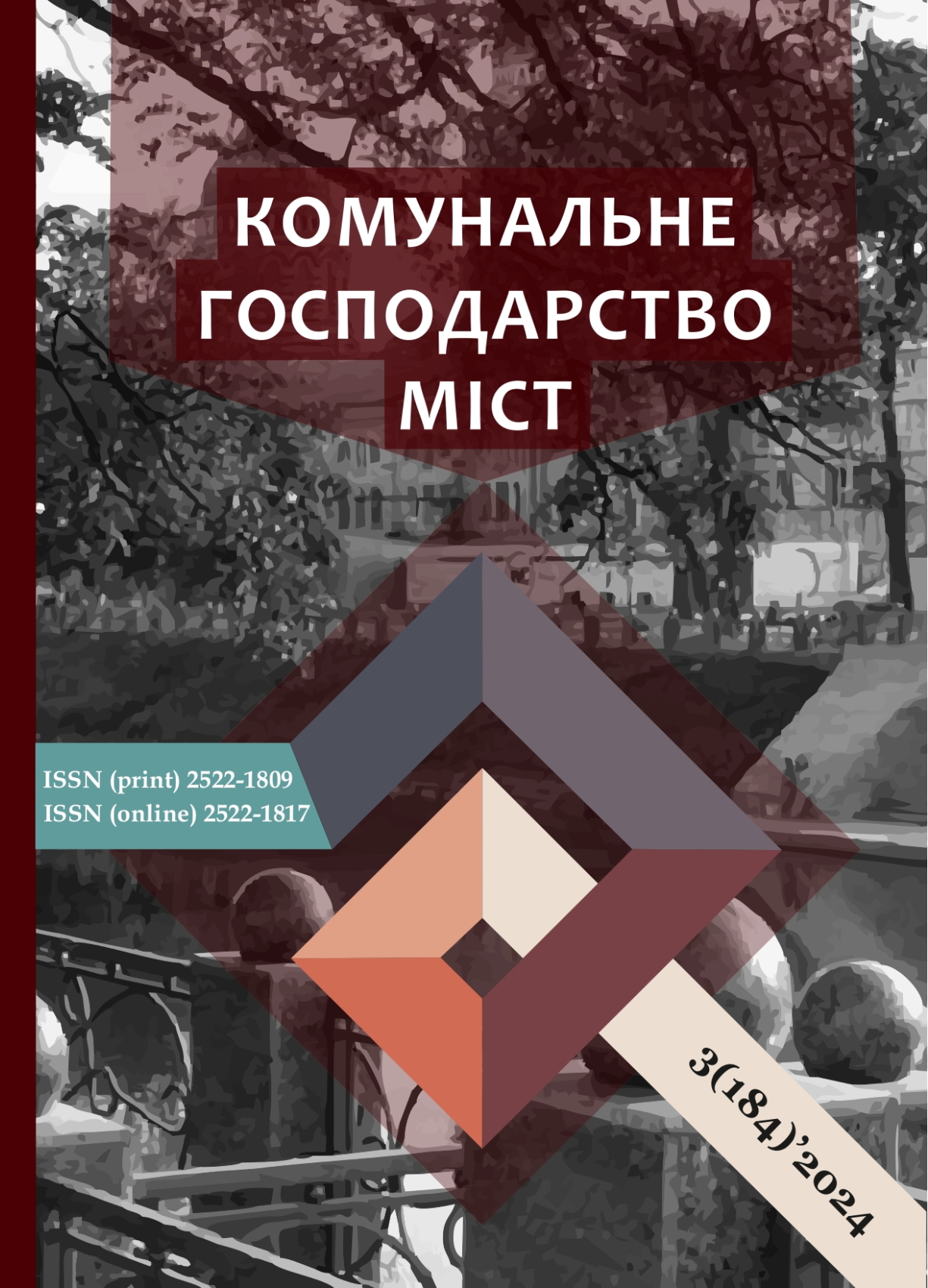PROBLEMS OF VISUAL QUALITIES OF THE ARCHITECTURAL ENVIRONMENT IN GREEN STANDARDS
DOI:
https://doi.org/10.33042/2522-1809-2024-3-184-65-70Keywords:
green standards, BREEAM, LEED, visual ecology, visual qualities, aesthetic propertiesAbstract
The architectural community, which is closely involved in green standards, is already aware of the need to consider the aesthetic qualities of the architectural environment in rating systems of environmental certification.
The study’s relevance is related to the need to find ways to factor the impact of the aesthetic component of architecture on human health in architectural projects. The purpose of the study is to justify the need to include the aesthetic properties of architectural objects under design in rating systems for environmental certification of architecture.
Rating systems for environmental certification of buildings are not universal; each has its characteristics. Analysis of the most common systems shows that they do not take into account and do not regulate the appearance of buildings from the point of view of human visual perception. At the same time, the visual and aesthetic qualities of the architectural environment affect human health and well-being, which makes them components of ecology and a matter for consideration. The author’s research focuses on some of the most common and basic standards: LEED, BREEAM, and WELL.
We determined that several green standards address the visual impact of architecture as a component of human health and ecology. We also found that during certification, according to the relevant standard, in most cases, the visual impact comes down to providing a view from the window, the level of lighting inside the room, and insolation, among others. At the same time, there is no regulation of the aesthetic impact of a building on a person; there is no methodology for its evaluation.
There is an obvious need to consider the aesthetic qualities of architecture. Its quantification and scoring are possible within the framework of the corresponding credits of the environmental certification rating system. For this, we propose an appropriate technique, which consists of conducting a statistical survey of some categories of respondents who answer a series of questions about visual perception and give a generalised assessment of the architectural project.
The study substantiates the expediency of introducing criteria for assessing the aesthetic properties of architectural structures into the system of green standards; it analyses the requirements of green standards regarding the aesthetic properties of the architectural environment. The article also develops the principles of forming criteria for assessing the aesthetic properties of architectural structures. It argues that the aesthetic visual qualities of architectural objects affect human health and that we should consider them in the environmental certification systems of architecture. Therefore, the study is forming a unified green standard template, one of the criteria of which will allow for the awarding of points for the visual environmental friendliness of a building undergoing green certification.
References
Dewey, J. (1934). Art as experience. The Berkeley Publishing Group, New York.
Fomenko, O., Danilov, S. (2017). Nonlinearity and Instability of the Architecture Language. Space & Form, (30), 137-154. https://doi.org/10.21005/pif.2017.30.C-02.
Ivanaj, V., Shrivastava, P., Silvester I. (2018). The value of beauty for organizations. Journal of Cleaner Production, (189), 864-877. https://doi.org/189. 10.1016/j.jclepro.2018.04.122.
Cribb A., Pullin G. (2022). Aesthetics for everyday quality: one way to enrich healthcare improvement debates. Med Humanit, (48), 480–488. https://doi.org/10.1136/medhum-2021-012330.
St-Jean, P., Clark, O., Jemtrud, M. (2019). A review of the effects of architectural stimuli on human psychology and physiology. Building and Environment, (219). https://doi.org/10.1016/j.buildenv.2022.109182.
Dijkstra K., Pieterse M., Pruyn A. (2006). Physical environmental stimuli that turn healthcare facilities into healing environments through psychologically mediated effects. Systematic review. Journal of Advanced Nursing, (Vol. 56, №2), 166–181.
Golembiewski J.A. (2010). Start making sense: Applying a salutogenic model to architectural design for psychiatric care. Facilities, (Vol. 28, №3-4), 100–117.
Brick, S. (2022). Improving health in the military and beyond using salutogenic design. Facilities, (Vol. 40, №15/16), 54-71. https://doi.org/10.1108/F-06-2021-0058
Roskams, M., Haynes, B. (2019). Salutogenic workplace design. Journal of Corporate Real Estate. (Vol. 22, №2), 139–153. https://doi.org/10.1108/jcre-01-2019-000.
United Nations Development Programme. Вилучено з https://www.undp.org/
United States Department of Defense (2008). Unified facilities criteria (UFC). DoD security engineering facilities planning manual. Вилучено з https://www.wbdg.org/FFC/DOD/UFC/ufc_4_020_01_2008.pdf
Payne, C., Dyer, B. (2021). Federal Participation in LEED, Ernest Orlando Lawrence Berkeley National Laboratory. Berkeley, CA.
Chechelnytskyi, S.G. & Fomenko, O.O. (2012). Videoekolohiia arkhitekturnoho seredovyshcha. Kharkiv: O.M. Beketov NUUEKh.
U.S. Environmental Protection Agency. (2013). Creating Equitable, Healthy, and Sustainable Communities: Strategies for Advancing Smart Growth, Environmental Justice, and Equitable Development. Accessed https://www.epa.gov/sites/production/files/2014-01/documents/equitable-development-report-508-011713b.pdf
Gochfeld M., Burger J. (2011). Disproportionate Exposures in Environmental Justice and Other Populations: The Importance of Outliers. Am J Public Health, (101), 53-63. https://doi.org/10.2105/AJPH.2011.300121
Ivanaj V, Shrivastava P, Ivanaj S. (2018). The value of beauty for organizations. J. Clean Prod., (189). https://doi.org/10.1016/j.jclepro.2018.04.122.
Google UX Design Professional Certificate Coursera. Accessed https://www.coursera.org/professional-certificates/google-ux-design
Downloads
Published
How to Cite
Issue
Section
License
The authors who publish in this collection agree with the following terms:
• The authors reserve the right to authorship of their work and give the magazine the right to first publish this work under the terms of license CC BY-NC-ND 4.0 (with the Designation of Authorship - Non-Commercial - Without Derivatives 4.0 International), which allows others to freely distribute the published work with a mandatory reference to the authors of the original work and the first publication of the work in this magazine.
• Authors have the right to make independent extra-exclusive work agreements in the form in which they were published by this magazine (for example, posting work in an electronic repository of an institution or publishing as part of a monograph), provided that the link to the first publication of the work in this journal is maintained. .
• Journal policy allows and encourages the publication of manuscripts on the Internet (for example, in institutions' repositories or on personal websites), both before the publication of this manuscript and during its editorial work, as it contributes to the emergence of productive scientific discussion and positively affects the efficiency and dynamics of the citation of the published work (see The Effect of Open Access).

